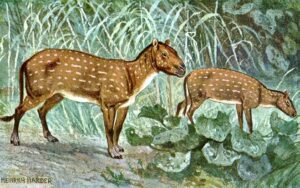Herne Bay is home to many great things and many great people, but did you know that at one point it could also lay claim to being the birthplace of the horse thanks to palaeontologist William Richardson?
Horses have a rich history in Kent – the symbol of the county is Invicta, the white horse, which is thought to be a reference to Hengist and Horsa, the Viking warriors who landed at Thanet and were given Kent as a peace offering from King Vortigern. Furthermore, one of the earliest fossils thought to be of a horse was found in the cliffs at Studd Hill near Herne Bay in 1838. The momentous find was made by a palaeontologist called William Richardson. Richardson found a fragment of a skull in the Herne Bay mud, and passed the tiny fossil on to Sir Richard Owen, who was working at the British Museum at the time. Owen was a famed naturalist who would become the first director of the Natural History Museum in London. He did a lot of research with fossils, and in fact coined the term “dinosaur” (“terrible lizard”).
When he first presented Richardson’s fossil to his peers, Owen described it as probably belonging to a rodent, although he also noted similarities to the hyrax, a small mammal native to Africa and the Middle East; he would later posit that the fossil was in fact a kind of early horse, naming it Hyracotherium. In 1876, the American scientist Othniel C. Marsh discovered a whole skeleton of Hyracotherium in New Mexico, and it seemed that the history and evolution of the horse was firmly pinned in place, starting with Richardson’s fossil, which was called the “Dawn Horse”.
Nowadays, however, Hyracotherium has been reclassified, and it’s thought not to be a horse after all, but rather a palaeotheriidae, a now-extinct herbivorous mammal related to horses. It would have been an odd-toed ungulate (large mammals with hooves) around the size of a fox, and would have probably eaten leaves, berries, and other plant matter it could have picked up from the forest floor.



